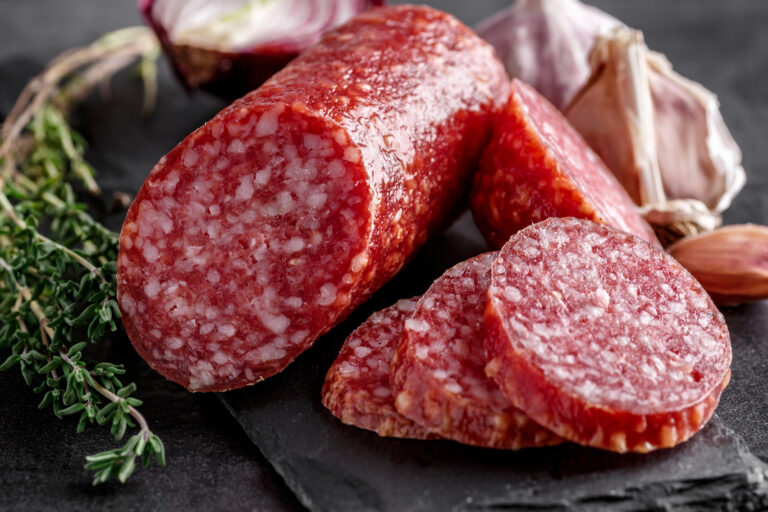7 Differences Between Iberico vs Serrano Ham to Elevate Your Charcuterie Board
Iberico and Serrano hams: Spanish delicacies with distinct flavors. Learn the origins, curing methods, flavors, textures, and nutritional benefits of each.

Iberico and Serrano hams are Spanish delicacies that tantalize taste buds with distinct flavors. Discover what sets these cured meats apart and why each deserves a spot on your charcuterie board.
Disclosure: As an Amazon Associate, this site earns from qualifying purchases. Thank you!
Distinct Origins and Varieties

Knowing where your ham comes from is key to understanding its flavor.
Iberico Ham: Sourcing and Types
Iberico ham, or Jamón Ibérico, originates from the Iberian Peninsula. Authentic Iberico ham is sourced from Black Iberian pigs.
- Jamón Ibérico de Cebo: Pigs are grain-fed.
- Jamón Ibérico de Cebo de Campo: Pigs split their diet between grain and pasture.
- Jamón Ibérico de Bellota: Pigs forage on acorns, giving rich, nutty flavor.
Serrano Ham: Sourcing and Types
Serrano ham, or Jamón Serrano, hails from the mountainous areas of Spain. It’s typically made from white pigs.
- Jamón Serrano Bodega: Cured for 9-12 months.
- Jamón Serrano Reserva: Cured for 12-15 months.
- Jamón Serrano Gran Reserva: Cured for over 15 months.
Understanding these origins and types can help you pick the right ham for your culinary needs.
Making Process: A Comparison

The Diet and Breeding of the Pigs
Iberico pigs feast on acorns, wild herbs, and grain, creating rich, nutty flavors. They roam freely across dehesas, a practice boosting muscle quality and flavor. Serrano pigs, however, are bred in controlled farms and feed on cereals and animal feed, resulting in a milder taste.
Key Stages in the Curing Methods
Iberico ham undergoes salting, resting, curing, and aging in varying conditions. Salting lasts around two weeks, followed by resting for up to 40 days, curing for six months, and aging for up to four years, developing complex flavors. Serrano ham is similarly salted for about ten days, rested for 40 days, and cured for six months, but aged up to a year, offering a smoother flavor profile.
| Step | Iberico Ham | Serrano Ham |
|---|---|---|
| Salting | ~2 weeks | ~10 days |
| Resting | Up to 40 days | 40 days |
| Curing | 6 months | 6 months |
| Aging | Up to 4 years | Up to 1 year |
Flavor Profiles and Textures
Identifying the Unique Flavors of Iberico Ham
Iberico ham delivers an intense, nutty flavor. Thanks to the acorn-rich diet of the pigs, you’ll notice hints of sweet, earthy tones. These flavors are enhanced by the lengthy curing process, which can last up to four years. The result is a complex taste that deepens with each bite.
Distinctive Textures of Both Hams
Iberico ham has a melt-in-your-mouth texture. The high-fat content creates a silky, almost creamy consistency. In contrast, Serrano ham offers a firmer, more uniform texture due to its shorter aging process of up to one year. Serrano’s leaner cuts provide a chewier yet savory experience.
Nutritional Values and Benefits

Health Benefits of Iberico Ham
Iberico ham stands out not just for its flavor but its nutritional perks. Packed with oleic acid, it boosts heart health. High levels of healthy fats can help lower bad cholesterol. Being rich in protein, it supports muscle maintenance. Vitamins B1 and B12 aid in proper nerve and blood cell functions.
Nutritional Insights into Serrano Ham
Serrano ham provides distinct benefits in a leaner package. Lower fat content makes it an excellent protein source for low-fat diets. Rich in essential amino acids, it aids in tissue repair and muscle growth. Vitamin B6 in Serrano ham enhances immune function. High mineral content, including iron and zinc, contributes to overall health.
Culinary Uses in Dishes

Traditional Spanish Dishes Using Iberico Ham
In Spanish dishes, Iberico ham shines for its rich flavor and versatility.
- Jamón Ibérico Croquettes
Combine bechamel sauce with finely chopped Iberico ham, coat in breadcrumbs, and fry. Perfect tapas. - Pan con Tomate
Rub toasted bread with garlic and ripe tomatoes, drizzle with olive oil, and top with Iberico slices. - Salmorejo
Blend tomatoes, bread, and garlic, drizzle with olive oil, and add crispy Iberico bits. Cold soup with a kick.
Popular Recipes Incorporating Serrano Ham
Serrano ham’s firm texture makes it ideal for various recipes.
- Serrano Ham and Melon
Wrap slices around cantaloupe or honeydew wedges. Simple and refreshing. - Ham-Wrapped Asparagus
Roll Serrano around asparagus spears and roast until crispy. Quick and elegant side dish. - Serrano Ham and Manchego Cheese Plate
Serve Serrano slices with aged Manchego. Ideal for charcuterie boards.
Price and Accessibility

Iberico and Serrano hams differ significantly in price and availability.
Why Iberico Ham Tends to Be More Expensive
- Breed: Iberico pigs, native to Spain, are rarer compared to the white pigs used for Serrano ham.
- Diet: Iberico pigs are fed acorns and wild herbs, driving up costs.
- Aging: Iberico ham is aged up to four years, while Serrano ham is typically aged up to one year.
- Labor: The labor-intensive process for Iberico ham includes hand-selecting pigs and meticulous curing.
Availability
- Local Retailers: Check specialty food stores or gourmet shops for both hams.
- Online: Numerous online retailers offer a range of options for Iberico and Serrano ham.
- Label Check: Look for “Jamón Ibérico de Bellota” for premium Iberico and “Jamón Serrano” certified by Consorcio del Jamón Serrano Español.
- Portion Sizes: Consider starting with smaller portions if you’re trying these hams for the first time.
How to Properly Store and Serve
Best Practices for Storing Both Types of Ham
Store Iberico and Serrano hams in a cool, dry place. The ideal storage temperature is between 50-59°F (10-15°C). Use a ham stand to keep it stable and a cotton cloth to cover it. This allows air circulation while protecting from dust. Refrigerate sliced ham for long-term storage. Wrap tightly in plastic wrap or store in a vacuum-sealed bag to prevent drying out. Label and date packages for freshness.
Serving Tips to Enhance Flavor and Experience
Serve Iberico and Serrano hams at room temperature. Let the slices sit for at least 30 minutes before serving. This releases aromatic flavors. Slice thinly with a sharp knife. Cut against the grain to achieve the best texture, maximizing flavor release. Pair with traditional accompaniments. Serve with Manchego cheese, fresh bread, olives, and a glass of Spanish wine such as Tempranillo or Rioja. This complements the ham’s rich, savory profile.
Consumer Preferences and Market Trends

Trends Influencing Ham Choices
- Economic Factors Impacting Purchases: Budget considerations often steer consumers towards Serrano Ham for its affordability compared to the pricier Iberico.
- Health Conscious Choices: Increasing demand for high-quality, nutrient-rich foods has many leaning towards Iberico ham, rich in healthy fats due to acorn-fed diets.
- Culinary Exploration: A growing trend in gourmet cooking and food experiences fuels interest in both types of ham, with Iberico often seen as the premium option.
Consumer Reviews and Preferences Between Iberico and Serrano
- Taste Experiences: Many reviews praise Iberico for its complex, nutty flavor, while Serrano is often highlighted for its milder, but still delightful taste.
- Texture Preferences: Iberico is favored for its tender, melt-in-your-mouth texture, whereas consumers appreciate Serrano for its firmer, chewier consistency.
- Availability and Accessibility: Regional preferences show that consumers in areas with limited access to specialty shops may prefer Serrano, which is more readily available.
- Price Sensitivity: Price-conscious buyers frequently opt for Serrano due to its lower cost, while those willing to splurge will go for the luxurious experience of Iberico.
Frequently Asked Questions
What is the main difference between Iberico and Serrano ham?
Iberico ham comes from Iberico pigs that feed on acorns and wild herbs, offering a rich, nutty flavor. Serrano ham is from pigs raised on cereals and animal feed, resulting in a milder taste.
What is the curing process for Iberico and Serrano ham?
Both hams undergo salting, resting, curing, and aging. Iberico ham is cured for up to four years, while Serrano ham is typically cured for up to one year.
Why is Iberico ham more expensive than Serrano ham?
Iberico ham is more costly due to the rarity of the breed, their specialized acorn diet, longer aging process, and labor-intensive production.
How should I store Iberico and Serrano ham?
Store them in a cool, dry place. For long-term storage, keep sliced ham refrigerated. Always serve at room temperature for the best experience.
Where can I buy Iberico and Serrano ham?
You can purchase these hams from local retailers, online stores, and specialty shops. Look for label certifications to ensure authenticity.
What are the best accompaniments for Iberico and Serrano ham?
Serve these hams with bread, cheese, olives, and wine to complement their flavors and enhance the dining experience.
How do consumer preferences affect the choice between Iberico and Serrano ham?
Preferences are influenced by taste, texture, availability, price sensitivity, and market trends, including economic factors and health considerations.
What are the nutritional differences between Iberico and Serrano ham?
Iberico ham tends to have a higher fat content, offering deeper flavors, while Serrano ham is leaner with a simpler taste profile.
How do I know which ham to choose for the first time?
Consider starting with smaller portions. Iberico ham offers a richer experience, while Serrano ham provides a milder introduction to cured meats.
Can I find good-quality Iberico and Serrano ham online?
Yes, many reputable online stores offer these hams with authenticity certifications. Always check reviews and ratings before purchasing.






